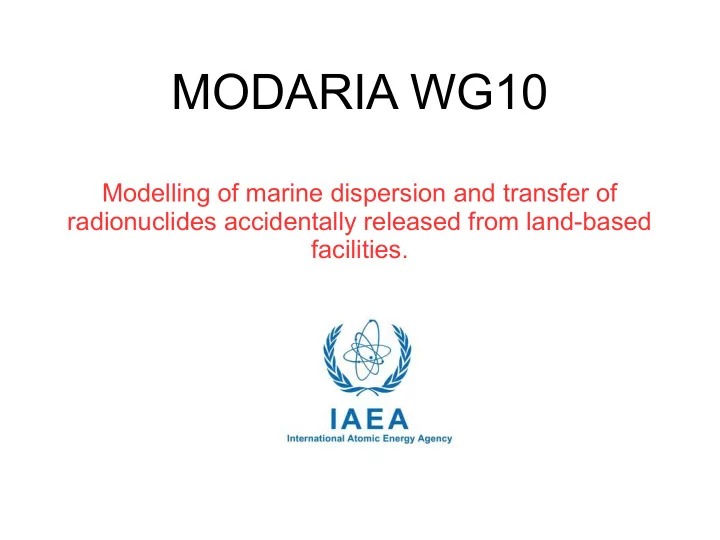

MODARIA WG10 Modelling of marine dispersion and transfer of radionuclides accidentally released from land-based facilities.
Interim meeting ● University of Seville, Spain. 17-19 June, 2015 ● Participants from Rep. of Korea, Japan, Ukraine, Norway, Spain ● Discussions: – Last Fukushima exercise: final results – Final report – Preparation of papers – Plans for MODARIA-II – Joint meeting with WG3
WG 10 results R. Periáñez, R. Bezhenar, M. Iosjpe, V. Maderich, H. Nies, I. Osvath, I. Outola, G. de With ● (2015). A comparison of marine radionuclide dispersion models for the Baltic Sea in the frame of IAEA MODARIA program. Journal of Environmental Radioactivity 139, 66-77. R. Periáñez, I. Brovchenko, C. Duffa, K.T. Jung, T. Kobayashi, F. Lamego, V. Maderich, B.I. Min, ● H. Nies, I. Osvath, M. Psaltaki, K.S. Suh (2015). A new comparison of marine dispersion model performances for Fukushima Dai-ichi releases in the frame of IAEA MODARIA program. Journal of Environmental Radioactivity 150, 247-269. R. Periáñez, R. Bezhenar, I. Brovchenko, C. Duffa, M. Iosjpe, K.T. Jung, T. Kobayashi, F. ● Lamego, V. Maderich, B.I. Min, H. Nies, I. Osvath, I. Outola, M. Psaltaki, K.S. Suh, G. de With. An overview of marine pollution modelling activities in IAEA (International Atomic Energy Agency) MODARIA program: lessons learnt from the Baltic Sea and Fukushima scenarios. Submitted to Marine Pollution Bulletin. R. Periáñez, R. Bezhenar, I. Brovchenco, Byung-Il Min, C. Duffa, M. Iosjpe, K. Jung, T. ● Kobayashi, Kyung-Suk Suh, F. Lamego, V. Maderich, H. Nies, I. Osvath, I. Outola, M. Psaltaki, G. de With. MODARIA Marine Transport Modelling. In International Expert Meeting on Assessment and Prognosis in Response to a Nuclear or Radiological Emergency. Vienna, 20-24 April 2015. WG-10 Final Report: Draft finished ●
WG10 scenarios on accidental releases in the marine environment 1) Fukushima releases in the Pacific Ocean ● Intercomparison of hydrodynamic submodels ● Intercomparison of dispersion models 2) The Baltic Sea: modelling Chernobyl fallout ● Results provided by 4 models: ● NRPA box model ● POSEIDON box model ● USEV hydrodynamic model ● THREETOX hydrodynamic model ● Results compared with HELCOM database measurements
Baltic Sea scenario 5 year of calculation from October 31, 1986 Maps of 137-Cs concentration in surface water and sediments in October 31, • 1991 Time series of 137-Cs inventories in the water column and bed sediments • Time series of concentrations in water and sediments at selected locations • Mean concentrations in water and sediments in several sub-basins •
Model results compared with HELCOM data
Applied models ● POSEIDON box model ● NRPA box model ● THREETOX: 3D hydrodynamic model ● USEV: 2D depth-averaged model, forced with annual mean wind Water/sediment interactions included in all models
Inventories in the Baltic
Calculated and measured concentrations in water Magenta: POSEIDON Red: THREETOX Green: NRPA Blue: USEV
Calculated and measured concentrations in sediments Magenta: POSEIDON Red: THREETOX Green: NRPA Blue: USEV
Concentrations in sediments (Bq/kg) after 5 years USEV
Fukushima: participating models Institute Scale Circulation Model type KAERI Regional, NCOM, Lagrangian global JCOPE2 JAEA Local, Kyoto Lagrangian regional, University global Univ. Tolouse Regional Own, NCOM Eulerian bound. cond. Univ. Seville Local JCOPE2, Eulerian HYCOM IEN, Brasil Local Own Eulerian NTUA, Greece Local Own Eulerian IMMSP/KIOST regional Own, HYCOM Eulerian and Ukraine bound. cond. Lagrangian All models are three-dimensional dynamic models
Fukushima first modelling exercise Constant release (hypothetical magnitude) of a perfectly conservative radionuclide (no water/sediment interactions) Compare time series of concentrations at the sea surface for the period March 11-May 30
Results Each team uses its own hydrodynamics Constant hypothetical release Conservative radionuclide
What is happening? ● Baltic Sea: very different models and similar results ● Fukushima: similar models and different results ● A marine dispersion model consists of two sub- models: – Hydrodynamic sub-model – Dispersion sub-model (transport by currents, turbulent mixing, water/sediment interactions) ● Let´s try to know the origin of discrepancies: model harmonization
Current field examples, April 30th (sea surface) NCOM Kyoto Univ. JCOPE2
Time series of currents
Exercise 2: tracer All models use JCOPE2 model circulation Same constant hypothetical release
Exercise 2: 137-Cs (water/sediment interactions included) P2
Exercise 3 ● Same circulation ● Exactly the same bathymetry ● Same diffusion coefficients ● Same adsoption/desorption parameters ● In the case of a tracer, results do not significantly improve with respect to exercise 2. The main reason of discrepancy between models is water circulation
Exercise 3: 137-Cs P2
Next step: comparisons with measurements (exercise 4) Atmospheric deposition: from atmospheric dispersion models Direct releases: reconstructed from TEPCO measurements in the release area
Points sampled by TEPCO Exercise 4a (same circulation, parameters) Exercise 4b (modeler expertise)
Concentrations in sediments (Bq/kg) JAEA-4a JAEA-4b (JCOPE2) (Univ. Kyoto)
Conclusions ● Dispersion models are robust tools (consistent results in the Baltic), but: ● Large differences in model output occur in highly dynamic systems, with strong and variable currents (model harmonization required in Fukushima) ● This highlights the difficulties in developing operative models for decision-making support in these dynamic environments ● Further research in this field is required (MODARIA-II?)
Plans for this week ● Final report ● Further discussions on MODARIA-II possible topics
Recommend
More recommend